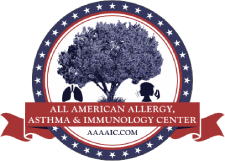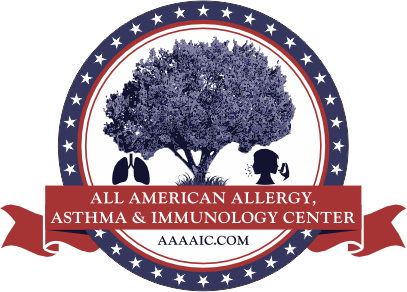Background – Up to 70% of US households have at least 1 pet. Pets have become an integral part of our lives as they are part of our family. Most people have dogs and or cats. However, small rodents, livestock, reptiles, birds and amphibians are other common pets. The allergenic protein in pets can be in their dander and urine and saliva. Their pelt can also expose you to pollen as they are like a magnet for outdoor pollen. Pet allergy can affect the sinuses (rhinitis, nasal polyps), skin (hives, eczema, dermatitis) and airways (asthma). Prolonged exposure can worsen all 3 conditions especially in children. However, we have therapies available that can potentially cure you of your pet allergy.
How it works/Pathophysiology – Exposure to pet dander or saliva that one is allergic to cause the immune system to produce an antibody (IgE). The IgE antibody in turns makes inflammatory cells (i.e mast cells and basophils) that line tissues of skin, upper and lower airways release inflammatory mediators such as Histamine and Leukotrienes. Inflammatory mediators such as Histamine cause the lining of the sinuses and airways to become itchy, produce mucous, and to swell causing stuffiness, congestion, wheezing, coughing, chest tightness and sinus pressure. It can also trigger movement of blood plasma out of tiny blood vessels to the skin surface, resulting in both hives (urticaria) and, occasionally swelling. The skin also becomes red and very itchy.
Symptoms –
- Raised, Red/Pale, Itchy welp like lesions that vary in size
- Sneezing
- Stuffy nose (nasal congestion)
- Sinus pressure
- Runny nose
- Tearing/Red eyes
- Dark circles under the eyes
- Mucus (phlegm) in the throat – this is also called “postnasal drip” or upper airway cough syndrome
- Itchy sinuses, throat, eyes, ears and skin
- Wheezing
- Coughing
- Chest tightness
Self-Treatment Tips –
- Limit your exposure to pets
- Wash hands and face immediately after direct interaction with pet (s)
- Steam clean carpets or remove carpets
- Vacuum with a HEPA filter to reduce dander in your home
- Change your AC filters at least every 2 months
- Wash your bed linens and pillowcases in hot water and detergent frequently
- Wash pets at least monthly
- Have pets to urinate and defecate in litter box or outside
- Use HEPA Air Purifiers in the house (small size 200 sq ft, medium size 200-400 sq ft, large size 400-1500 sq ft)
- Change vehicle air cabin filter at least every 2 months
- Take over the counter intranasal steroid such as fluticasone or nasocort along with second generation antihistamine such as Xyzal, Zyrtec, Claritin or Allegra; For ocular symptoms try otc ophthalmic antihistamine such as pataday or zaditor
- For sinus pressure and congestion an otc decongestant but for no longer than (3-4) days
- Otc hydrocortisone cream
- Otc Sarna for skin itching
- Cold wet compress applications
For More Natural therapy:
- For sinus pressure and congestion, application of warm damp compress to sinus
- For sinus pressure and congestion, steam inhalation; can also use essential oils such as peppermint or eucalyptus
- For sinus pressure and congestion, application of nasal saline spray
- For sneezing, runny nose and/or itchy sinuses, application of cold compresses to sinus
- For sinus pressure and congestion, topical mentholated ointment such as Vicks vaporub
- For sinus pressure, congestion and inflammation, sinus washes/lavage with Neilmed kit or Neti pot
- For “post nasal drainage” or cough, gurgling with warm salt lemon water
- For eye allergy symptoms, ophthalmic saline solution, cold compresses, aloe vera gel around eyes
Diagnostic Testing – Prick testing consist of pricking to introducing pet aeroallergens that are suspected triggers. 20 minutes later, the wheel and flare of the site is measured, and the allergy provider will discuss the results and overall interpretation.
In -Vitro allergy testing consists of whole blood draw at a local lab for which the whole blood is analyzed for the IgE antibody to pet aeroallergens. About 1.5 wks later, the allergy provider will discuss the results and overall interpretation.
Nasal Cytology testing consists of a nasal smear which is obtained safely and expediently via nasal swabs from each nasal cavity. It is useful, inexpensive and an easy diagnostic method to better detail the phenotypic characteristics of sinus symptoms. In fact, it allows to detect and quantify the cell population within the nasal mucosa at a given time. The technique involves sampling, processing and microscope reading. Sampling requires the collection of cells from the surface of nasal mucosa that is usually done by sterile swabbing. Samples are collected from the middle portion of the inferior turbinate where the ratio ciliate/mucinous cells is expected to be well balanced. The sample is stained on a slide and viewed/analyzed using optical microscopy with oil detecting the presence of inflammatory elements (eosinophils, mast cells, neutrophils and lymphocytes). Apart from the normal cell population, some specific cytological patterns can be of help in discriminating among various diseases. Viral infections, bacterial infections, allergic rhinitis, vasomotor rhinitis and overlapping forms can be easily identified.
Therapies:
Aeroallergy Immunotherapy (Allergy shots) – Allergy shots or AIT are subcutaneous injections of a small amounts of the specific aeroallergen(s) that you are allergic to. It is just enough to stimulate your immune system in order to desensitize your body over time, which causes your allergy sxs to diminish over time. It is up to 85% effective. Patients who are part of the effective group will first notice improvement within the first 4-8 months of therapy. It will continue to improve. Studies show that most patients will need to be on the maintenance phase of AIT for at least (3-5) years in order to obtain long lasting benefit. AIT is conducted in (2) phases. The buildup phase for routine AIT will require a shot 2 times a week for the first (8) weeks in most cases. The maintenance phase requires an AIT shot once every (2-4) weeks thereafter in most cases. The overall rate of adverse reactions for AIT in most large validated studies is <1%. For patient’s with lifestyle and schedule conflicts we also offer Cluster and Rush buildups, which enables faster time to the maintenance phase in 4 wks or less. Patients must be observed in the clinic for at least (30) minutes after each shot. Allergy shots are administered on a “walk in” basis during normal business hours, so there is no need for an appointment.
Sublingual Aeroallergen Immunotherapy (Allergy drops) – Allergy drops like allergy shots work by gradually helping your body build tolerance to the substance(s) that cause your allergies. The difference is that the antigen is placed under your tongue in a pain-free, liquid drop customized to your aero allergy profile. It is also nearly as effective as the shots and are safer. This form of immunotherapy is self-administered by patients. It is convenient for patients who don’t like needles, have time to come into the allergy clinic for a shot and or like to manage their own care in the convenience of their home or while traveling. Allergy drops are also very affordable. Please see the pricing tab for more information.
Osteopathic Manipulative Sinus Drainage (OMT) – OMT or sinus effleurage is a manual technique where the lymphatic system of the sinuses is opened and drained using gentle massage. It is used for patients who are actively experiencing sinus congestion or pressure.
Xolair (Omalizumab) – Xolair is a humanized monoclonal antibody that is administered by subcutaneous injection every 4 wks. It works by preventing the “allergy” inflammatory by binding free IgE antibodies (this is the antibody that triggers allergies) and by blocking certain receptors on inflammatory cells (i.e mast cells, basophils). Xolair is very effective and has a relatively small adverse effect profile. It essentially reduces or eliminates the need to take daily medications for hives such as antihistamines or steroids. This can be used for patients who have hives due to pet exposure.
Antihistamines – Antihistamines work by blocking histamine receptors on tissues thus eliminating and or reducing the influence of histamine on the body. Histamine is the chief cause of urtication or hives, sneezing, congestion, mucous production, watery/itchy eyes and itchy sinuses. Antihistamines come in various strengths, dosages, and types. They can be an excellent preventative and temporizing agent for pet allergy. Your allergy provider can work with you to find the most effective and suitable regimen.
Antileukotriene Agents – These agents act by disrupting the activation of leukotriene, which is one of the inflammatory mediators that are released in pet allergy. They can be effective in combination with antihistamines and/or steroids.
Corticosteroids – Corticosteroids or synthetic steroids agents that turn down the overall immune repose despite the trigger by preventing the conversion of phospholipids into arachidonic acid. It is often used for acute hives that are moderate-severe or severe asthma/rhinitis flares. It is administered for a few days up to several weeks. Due to its side effect profile, longer courses are tapered down overtime.
Topical Corticosteroids – Topical steroids work like the oral corticosteroids discussed above, but just locally wherever it is applied. They vary in potency and types.
Topical Calcineurin Inhibitors – Topical calcineurin inhibitors act by disrupting the inflammatory cascade involved in urticaria locally.

